This blog site is no longer updated. For the latest news from NASA’s Exploration Ground Systems, visit the website at http://www.nasa.gov/egs.
Mobile Launcher Rolls Back to Launch Pad 39B
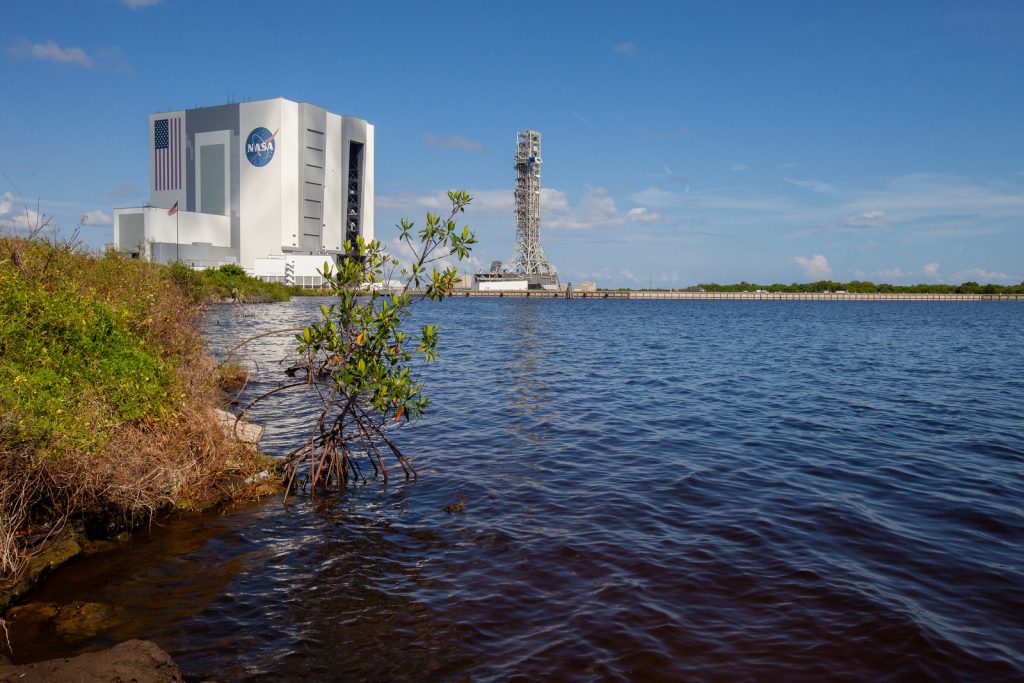 The mobile launcher for NASA’s Artemis missions rolls out of the Vehicle Assembly Building (VAB) at Kennedy Space Center in Florida on Sept. 10, 2019, after spending a week and a half inside due to the approach of Hurricane Dorian. The nearly 400-foot-tall structure was moved from Launch Pad 39B to the VAB for safekeeping on Aug. 30. The storm passed about 70 miles east of the spaceport during the overnight hours Tuesday, Sept. 3, and Wednesday, Sept. 4.
The mobile launcher for NASA’s Artemis missions rolls out of the Vehicle Assembly Building (VAB) at Kennedy Space Center in Florida on Sept. 10, 2019, after spending a week and a half inside due to the approach of Hurricane Dorian. The nearly 400-foot-tall structure was moved from Launch Pad 39B to the VAB for safekeeping on Aug. 30. The storm passed about 70 miles east of the spaceport during the overnight hours Tuesday, Sept. 3, and Wednesday, Sept. 4.
NASA’s Exploration Ground Systems is moving the mobile launcher back to the launch pad, where teams will complete testing and checkout on the launcher in the coming weeks for the Artemis I mission.
Photo credit: NASA/Ben Smegelsky
Bragging Rights for Mobile Launcher Lifters and Iron Workers
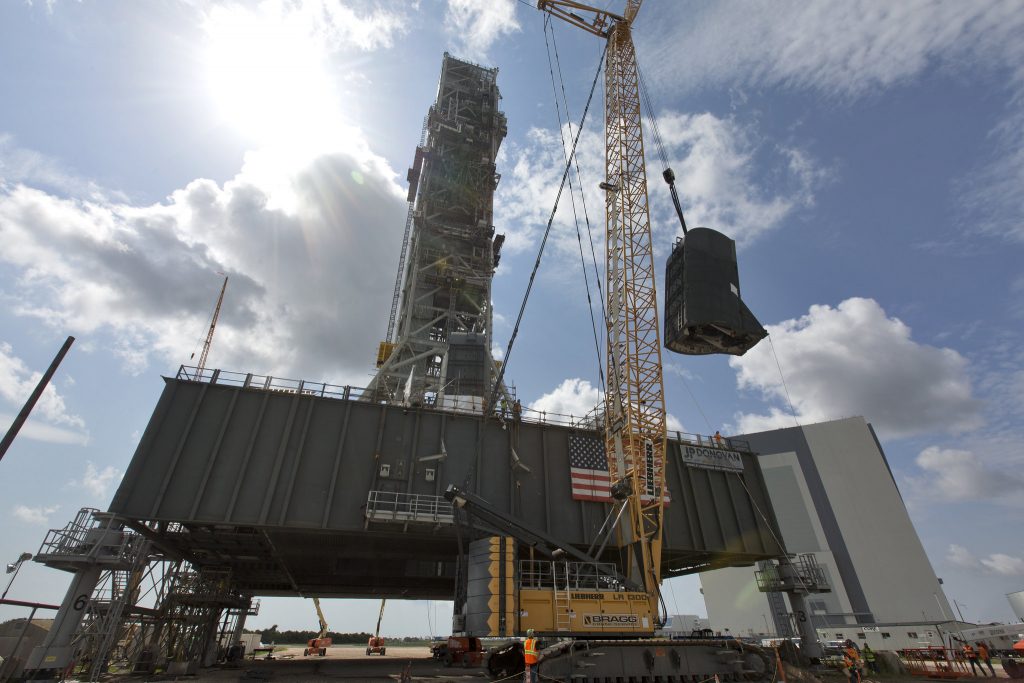
Operating a heavy-lift crane and working with some of the strongest metals on Earth takes precise diligence, skill and patience. Bragg Crane & Rigging Co. of Long Beach, California, has worked in the industry since 1946, and its team members embody these skills each day as they lift and weld a launch structure that will take America back to the Moon and on to Mars.
For the past four years, Bragg Crane & Rigging Co. has been supporting Kennedy Space Center’s Exploration Ground Systems (EGS) program, playing a crucial role in preparing the program’s mobile launcher for NASA’s Artemis missions. The company has had unique opportunities to lift and install most of the critical umbilicals to the mobile launcher that will provide power to the Space Launch System (SLS) and Orion spacecraft while on the launch pad. Among the major umbilical components the company installed were the crew access arm, which will allow astronauts to climb aboard the Orion spacecraft, and the tail service mast umbilicals, which provide fuel and electrical connection to the rocket.
During peak operations, the company had approximately 120 employees assembling the launcher, bringing NASA one step closer to putting the first woman and next man on the Moon. Bragg Crane & Rigging Co. is looking forward to supporting NASA’s missions to the Moon and beyond in the coming months under a new contract to continue to prepare the Vehicle Assembly Building for the integration of the massive SLS rocket.
Rotation, Processing and Surge Facility Ready for Artemis 1
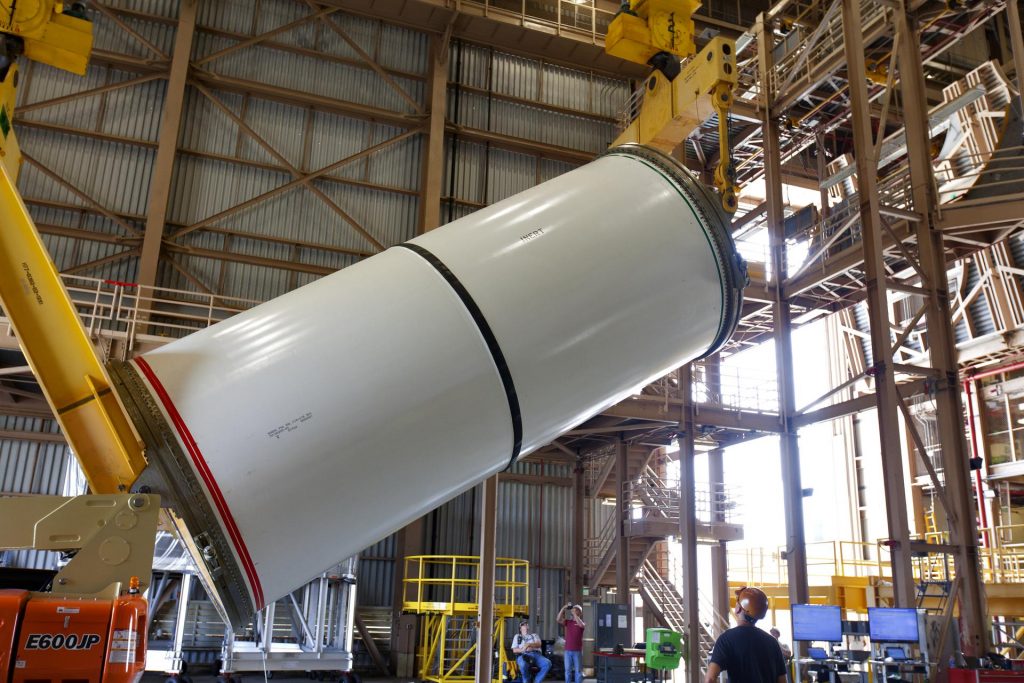
The Rotation, Processing and Surge Facility (RPSF) at NASA’s Kennedy Space Center in Florida will receive the solid rocket booster segments for final assembly of NASA’s Space Launch System (SLS) rocket. The agency’s Exploration Ground Systems (EGS) team successfully completed the system acceptance review and operational readiness review for the facility on July 25, 2019. This review evaluated the RPSF’s readiness to receive, process, integrate and launch flight hardware for Artemis 1 and beyond.
“The RPSF is the first processing facility at Kennedy to reach operational readiness status, and our team is looking forward to the arrival of the flight hardware so we can get to work preparing for the Artemis 1 launch,” said Mike Chappell, EGS associate program manager with lead contractor, Jacobs.
When the booster segments arrive at Kennedy, the pieces are inspected before two 200-ton cranes are positioned to lift the segments from a horizontal position to a vertical position. The RPSF also will receive the booster aft skirt from the Booster Fabrication Facility. During processing, the aft segment is attached to the aft skirt and aft exit cone.
All of the SLS solid rocket components processed in the RPSF will be transported to the Vehicle Assembly Building for final assembly with the SLS core stage and Orion spacecraft on top of the mobile launcher for the agency’s Artemis missions.
The RPSF is part of the infrastructure at Kennedy that will help NASA launch the Artemis missions and send the first woman and next man back to the Moon by 2024.
Mobile Launcher’s Crew Access Arm Successfully Tested
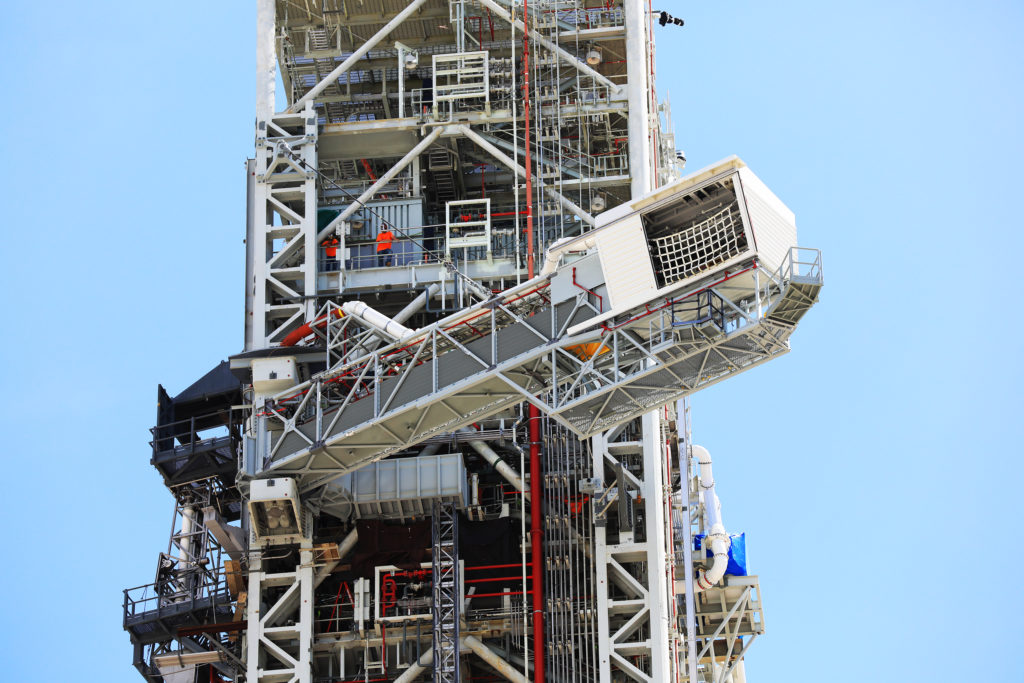
Photo credit: NASA/Kim Shiflett
As astronauts prepare for trips to destinations beyond low-Earth orbit, their last steps before boarding an Orion spacecraft will be across the Crew Access Arm (CAA) on the mobile launcher.
Earlier this year, the CAA was added to the mobile launcher being prepared to support NASA’s Orion spacecraft and Space Launch System (SLS) rocket, the largest in the world. Technicians and engineers in Exploration Ground Systems at the agency’s Kennedy Space Center recently tested the crucial arm, confirming it worked as designed.
The test was designed to determine the functionality and integrity of the CAA and supporting mobile launcher systems.
“This was the first functional swing testing for the Crew Access Arm,” said Cliff Lanham, Mobile Launcher Project Manager at Kennedy. “Prior to testing, we checked the mechanical attachment, hydraulics and cabling to make sure we had confidence it would work properly.”
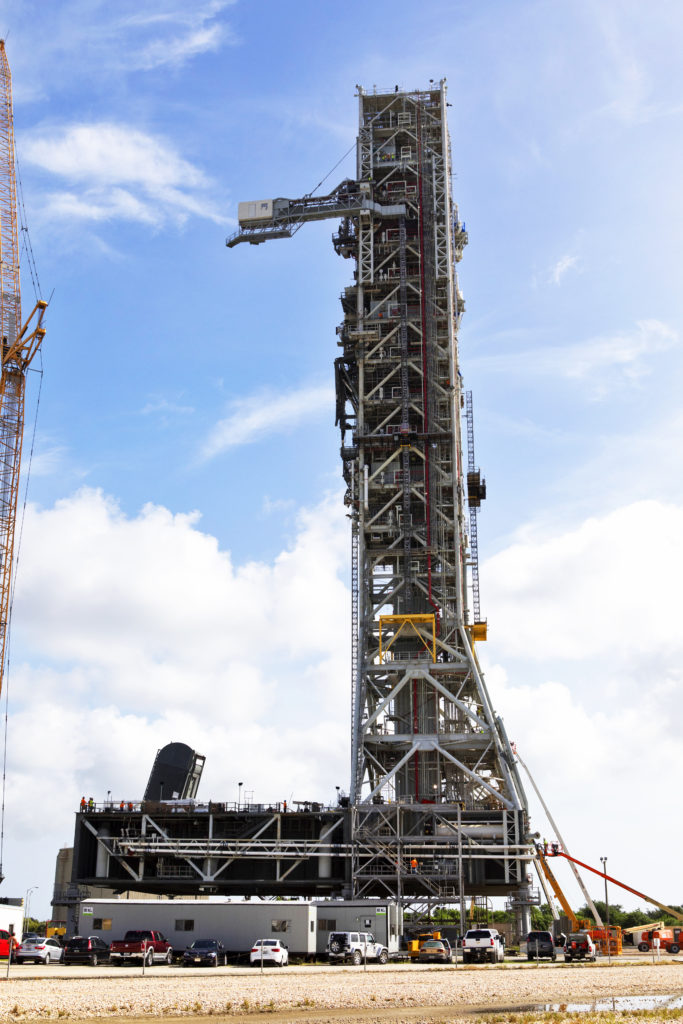
Photo credit: NASA/Kim Shiflett
The CAA is designed to rotate from its retracted position and line up with Orion’s crew hatch. The arm will provide entry and emergency egress for astronauts and technicians into and out of the Orion spacecraft.
In advance of those missions, the Exploration Ground Systems team at Kennedy has been overseeing testing of umbilicals and other launch accessories on the 380-foot-tall mobile launcher in preparation for stacking the first launch of the SLS rocket with Orion.
During the test, there were several moves of the arm controlled by systems on the mobile launcher. The test also was important because of the upcoming move of the mobile launcher from its park site to the Vehicle Assembly Building (VAB).
“The CAA will be extended when it goes inside the VAB,” Lanham said. “We cannot rotate the arm once in the VAB due to space constraints.”
Testing inside the VAB is designed to ensure all systems work properly in connection with the building prior to stacking the first SLS and Orion for Exploration Mission-1. EM-1 will be the first unpiloted flight of the new NASA spacecraft traveling 280,000 miles from Earth well beyond the Moon.
Engineers Mark Completion of Umbilical Testing at Launch Equipment Test Facility
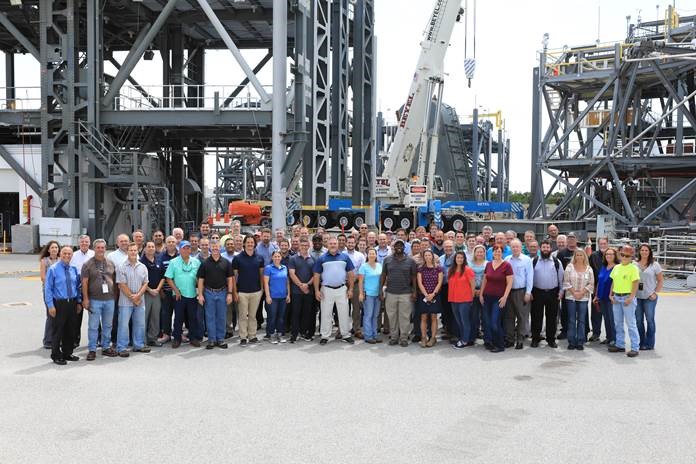
The team that tested the umbilical lines and launch accessories that will connect from the mobile launcher (ML) to NASA’s Space Launch System (SLS) rocket and Orion spacecraft for Exploration Mission-1 celebrated their achievement during a banner signing at the Launch Equipment Test Facility (LETF) at the agency’s Kennedy Space Center in Florida.
Engineers and technicians in the Engineering Directorate and the Exploration Ground Systems Program, along with contractor support, began the tests at the LETF about 2.5 years ago. The first to be tested was one of two aft skirt electrical umbilicals. Testing of the final umbilical, the second of two tail service mast umbilicals, was completed on June 27.
“The team of NASA test engineers and test managers, and contractor engineers and technicians, worked tirelessly six days a week, 10 hours a day, in order to meet the highly aggressive schedule and deliver the hardware to the mobile launcher for installation,” said Jeff Crisafulli, Test and Design branch chief in the Engineering Directorate.
In all, 21 umbilicals and launch accessories were tested on various simulators at the LETF that mimicked conditions during launch to ensure they are functioning properly and ready for installation on the ML. Most have been delivered and installed on the ML tower. These include the Orion service module umbilical, interim cryogenic propulsion stage umbilical, core stage forward skirt umbilical and core stage inter-tank umbilical. Two aft skirt electrical umbilicals, two aft skirt purge umbilicals, a vehicle stabilizer system, eight vehicle support posts and two tail service mast umbilicals were installed on the 0-level deck of the ML.
Before launch, the umbilical lines will provide power, communications, coolant and fuel to the rocket and spacecraft. Additional accessories will provide access and stabilization. During launch, each umbilical and accessory will release from its connection point, allowing the SLS and Orion to lift off safely from the launch pad.
“Design, fabrication and testing of the new mobile launcher’s umbilicals and launch accessories is a once-in-a-lifetime opportunity that I am proud to have been part of,” Crisafulli said.
First Tail Service Mast Umbilical Installed on Mobile Launcher for Exploration Mission-1
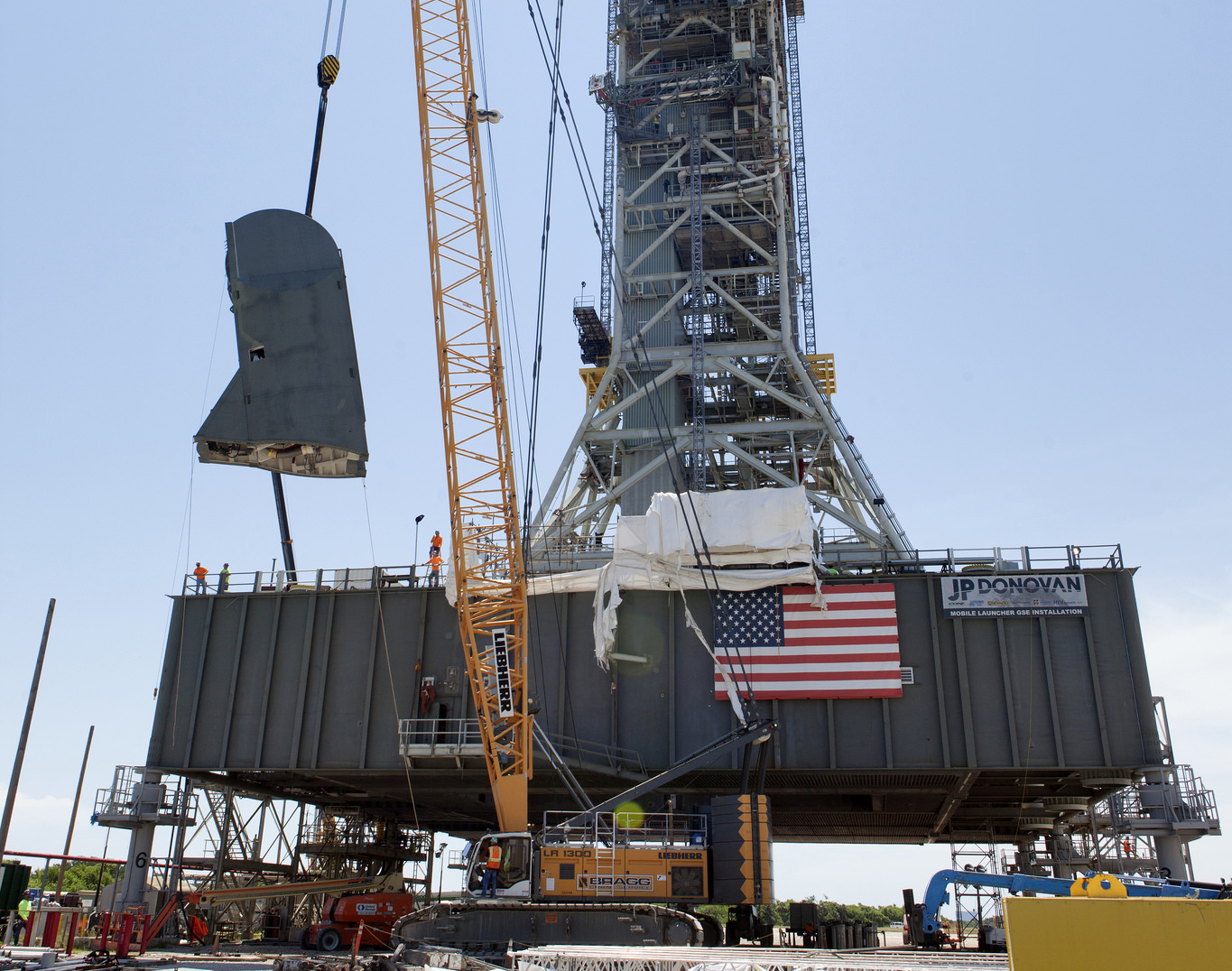 The first of two 35-foot-tall Tail Service Mast Umbilicals (TSMU) was lifted up and installed on the 0-level deck of the mobile launcher at NASA’s Kennedy Space Center in Florida. The installation brings the Exploration Ground Systems Program one step closer to supporting prelaunch operations for the agency’s Space Launch System (SLS) rocket and Orion spacecraft on Exploration Mission-1.
The first of two 35-foot-tall Tail Service Mast Umbilicals (TSMU) was lifted up and installed on the 0-level deck of the mobile launcher at NASA’s Kennedy Space Center in Florida. The installation brings the Exploration Ground Systems Program one step closer to supporting prelaunch operations for the agency’s Space Launch System (SLS) rocket and Orion spacecraft on Exploration Mission-1.
The TSMUs will connect to the SLS rocket core stage aft section and provide liquid oxygen and liquid hydrogen fluid lines and electrical cable connections to the core stage engine section to support propellant handling during prelaunch operations. This TSMU will provide the liquid oxygen.
Before launch, the TSMUs will tilt back to ensure a safe disconnect and retraction of all umbilical hardware away from the rocket during liftoff.
Photo credit: NASA/Kim Shiflett
Chilling Out During Liquid Oxygen Tank Test
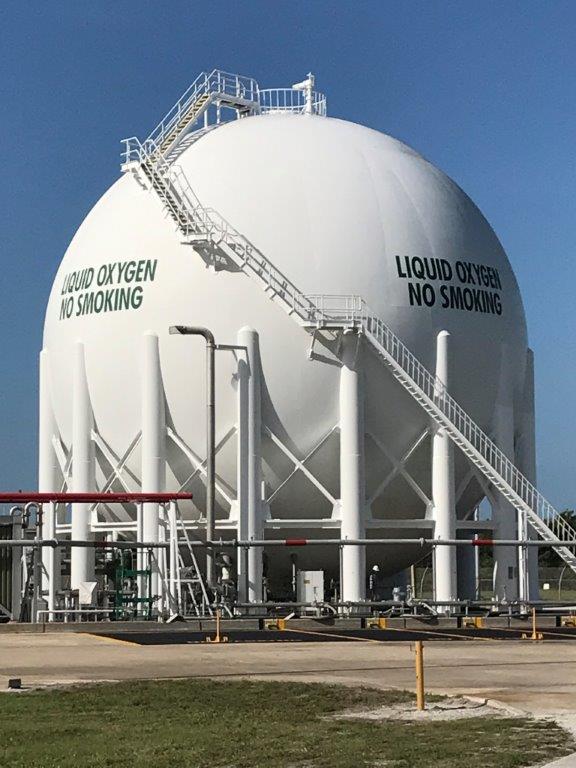
Exploration Ground Systems (EGS) chilled out recently with a pressurization test of the liquid oxygen (LO2) tank at Launch Pad 39B at NASA’s Kennedy Space Center in Florida – Pad 39B, recently upgraded by the EGS team for the agency’s new Space Launch System rocket.
The six-hour test of the giant sphere checked for leaks in the cryogenic pipes leading from the tank to the block valves, the liquid oxygen sensing cabinet, and new vaporizers recently installed on the tank.
The SLS will use both liquid oxygen and liquid hydrogen. During tanking, some of the liquid oxygen, stored at minus 297 degrees Fahrenheit, boils off and vapor or mist is visible. While the tank can hold up to 900,000 gallons of liquid oxygen; during the test it only contained 590,000 gallons of the super-cooled propellant.
The test was monitored by engineers and technicians inside Firing Room 1 at the Launch Control Center, a heritage KSC facility also upgraded by the EGS team in preparation for the upcoming mission. Results of the test confirmed that the fill rise rate was acceptable, the tank pressurization sequence works and that only one of the two vaporizers was needed to accomplish pressurization.
Another system is “go” for the first integrated launch of SLS and the Orion spacecraft!
Last of the Big Swing Arm Umbilicals Installed on Mobile Launcher

Nearly the last of several large connection lines, called umbilicals, was installed on the mobile launcher at NASA’s Kennedy Space Center in Florida. The umbilical was lifted by crane and attached high on the tower of the mobile launcher at about the 240-foot level, bringing the steel structure one step closer to supporting processing and launch of NASA’s Orion spacecraft and Space Launch System (SLS) rocket. The launcher is designed to support the assembly, testing, check out and servicing of the rocket, as well as transfer it to the pad and provide the platform from which it will launch.
This particular umbilical will supply propellants, environmental control systems, pneumatics and electrical connections to the interim cryogenic propulsion stage (ICPS) of the SLS rocket and will swing away before launch. The umbilical also will provide hazardous gas leak detection while the rocket is on the pad. The ICPS is located between the core stage of the rocket and the Orion capsule, and will provide propulsion for Orion while in space and give the spacecraft the big push needed to fly beyond the moon.
To install the umbilical, construction workers with JP Donovan prepared the rigging lines and attached the umbilical to a large crane. The ICPS umbilical was slowly lifted up and bolted to the mobile launcher. The entire process took about four hours.
With the umbilical in place, workers will install additional equipment on the tower, as well as electrical wiring, environmental control system tubing, hydraulics and other commodities will be routed to the umbilical arm before testing. Tests of the swing arm also will be performed as part of the verification and validation process.
Exploration Ground Systems is overseeing installation of the launch umbilicals and launch accessories on the mobile launcher to prepare for the first integrated test flight of Orion atop the SLS on Exploration Mission-1. A pair of tail service mast umbilicals are slated for installation later this year and will be the last of the twenty umbilicals and launch accessories to be installed on the mobile launcher. With this test flight, NASA is preparing for missions to send astronauts to deep space destinations, including the Moon, Mars and beyond.
NASA Recovery Team Completes Orion Underway Recovery Test 6 in Pacific Ocean

NASA’s Recovery Team from Kennedy Space Center just finished a week at sea, testing and improving their processes and ground support hardware to recover astronauts in the Orion capsule once they splash down in the Pacific Ocean. Aboard the USS Anchorage, NASA and the U.S. Navy worked together to run through different sea conditions, time of day and equipment scenarios—putting hardware and the people through their paces.
Astronaut Stephen Bowen was aboard as an observer to better understand the recovery procedures and to offer an astronaut’s perspective. As a former Navy captain, Bowen has a wealth of knowledge to impart to the team—helping them better understand what the crew will be going through as they are bobbing up and down in the capsule after spending time in microgravity.
“I understand what it’s like to be on a boat that doesn’t have a keel (a structural beam that runs in the middle from bow to stern to give it stability) in the open ocean,” Bowen said. “It’s not necessarily the friendliest of places to be.” And add that to the physical manifestations of re-entering a gravity environment after several weeks, Bowen’s first-hand knowledge will be paramount for the team as they hone their plans to make recovery smooth.
During the weeklong testing, the team made strides in developing the final recovery plan and even shaved 15 minutes off their best time. “When the astronauts return to Earth, we are required to retrieve them within two hours,” said NASA Recovery Director Melissa Jones, “but our goal is to get to them as quickly and safely as possible—we are shooting for half that time.”
The team still has several tests scheduled between now and Orion’s first uncrewed flight atop the new Space Launch System rocket, known as Exploration Mission-1. The mission will pave the way for future crewed missions and enable future missions to the Moon, Mars and beyond. During the flight, Orion will travel thousands of miles beyond the Moon before splashing down into the Pacific, where NASA’s Recovery Team will be ready and waiting for her.
